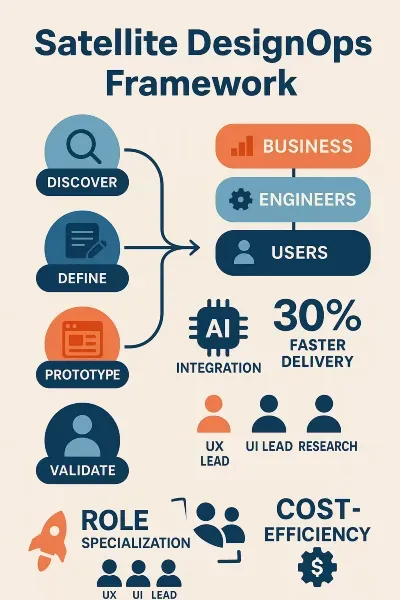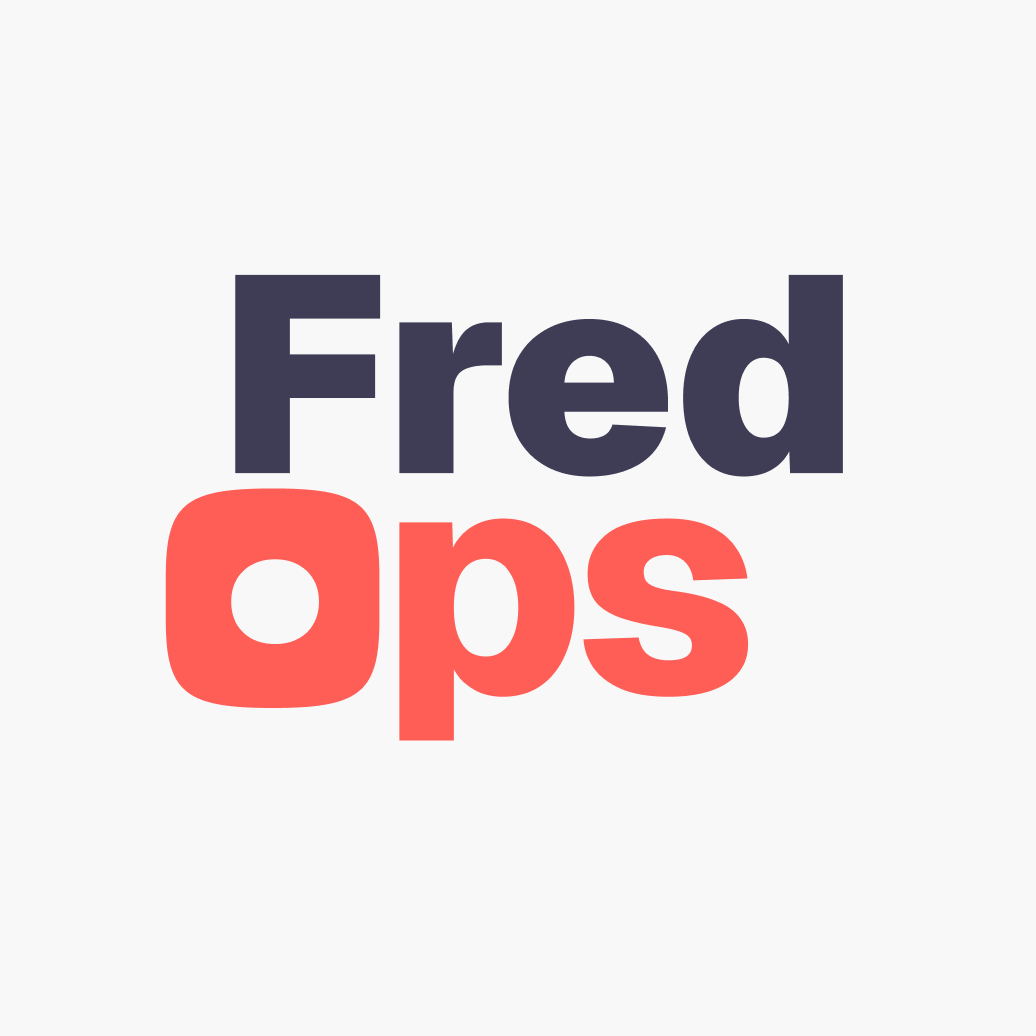Outsourced UX for Faster Delivery - Studio Founder's reflections

When I started working in software houses and later created my own effect-driven design studio, I encountered the same issues repeatedly across different software development agencies. There was a lack of understanding of the product creation process, design roles, and most importantly - the critical importance of design operations in the whole picture.
What I've seen was a lack of understanding of user research importance, confusion between UI vs UX roles, and missing communication between all stakeholders. This wasn't just a design problem - it was a fundamental design operations challenge that was creating bottlenecks and slowing down entire product development cycles.
What Design Operations Really Means in Software Consulting
Design operations is about adjusting specific workflows to the given context of the project and operating design wisely within the product operations space. It's not just about making things look pretty - it's about making the entire design process work efficiently with all stakeholders and meeting their expectations.
In consulting, design operations means adjusting to different contexts. In each project, we have different scenarios, competencies, and sets of people. Each stakeholder takes different responsibilities and expects different collaboration from their design team. The very first importance is discovering how things currently work - not to change them immediately, because when you enter as an external provider of design competencies, you must first understand their way of working.
You come there to help them, not to completely change how they work. You cannot say that their way of working is wrong from the very first view - you need to understand it first, see how it goes, and maybe suggest optimization.
The Satellite Design Studio Model: A Game-Changer
What I tried to invent is a way of working that allows huge involvement of all individuals and, first of all, improvement of time-to-market, quality of delivery, and quicker UX delivery since we are basically outsourced design power.
Our studio works as outsourced design competencies with me being an anchor and the relay point of contact between design and product software development. We act internationally, and what we found is that we can be about 30% faster in delivery compared to traditional in-house approaches.
Companies using outsourcing report an average reduction of 19% in operational expenses, and outsourcing partners often have teams ready to start immediately, reducing development cycle times and speeding up product launches.
Stakeholder Involvement: The Foundation of Effective DesignOps
We involve different stakeholders but categorize them regarding responsibility and importance. First, we put business requirements because they set the well-being of the project. Not all projects need to make money, not all projects need perfect UX - there are different business goals that need to be met first.
Later come engineers and users. When we start new projects, we often cannot think too much about end users initially because the real pain points and use cases - the business often understands these best, especially when we work with startups who are much closer to their user base.
Then there are engineering requirements. After all, what we design needs to be implemented by engineers. To ensure effective implementation, we need to understand what engineers expect and how they work. Communication is crucial here - we need to verify after each implementation stage whether it was done correctly, hand off documents in an understandable way, and keep daily communication for any issues.
Basically, the earlier we engage stakeholders, the better we can speed up processes and increase efficiency while reducing issues.
The Power of Role Specialization vs. The Unicorn Myth
Specialization works better than expecting unicorns, because unicorns are very seldom met. I'm more of a user research and UX person, but I don't have the creativity for colors and visual style to make things attractive. That's the clear separation between UX and UI roles.
What I see often is that UI or artistically gifted people tend to lack analytical skills. Making the team with clear role separation - having UX lead, UI lead, and user research lead - assures high quality regardless of individual skill sets, because some designers can do a bit of both, but specialization is key.
This structure is also good for scaling the team. If you want more work done on a project, you can bring product designers assisting the UX/UI leads, who still manage tasks and maintain quality control.
How Companies Can Collaborate with External Design Studios
Companies can lease designers, outsource design work, or integrate design teams into their workflow. In my point of view, leasing a designer means not taking responsibility for design operations, and that's often something companies aren't aware of.
What I found most valuable is having a satellite design studio that collaborates on-site, addressing issues while suggesting improvements and progressing with work. This is especially effective for smaller companies with four or five developers.
For a development team of four to five people, we typically allocate about 160 hours per month of design work, distributed equally between user research, UX design, and UI design. You wouldn't have a specialist very good in all those skills in-house. Working with a studio, you get specialists with experience from multiple projects, understanding how effective software development works.
Outsourcing allows businesses to accelerate time to market, reduce development costs, and maintain access to specialized professionals with domain-specific knowledge. We could be even 50% cheaper compared to having an equivalent design team in-house.
Discover, Define, Prototype, Validate: Our DesignOps Framework
We work most often with the discover-define-prototype-validate methodology. This structured approach helps us understand:
- How the product currently looks and what's working
- What was tried before and why certain conclusions were made
- How their software development process works
- Whether they use design systems
- Whether they have skillful front-end developers who don't need very specific UI designs
- How active the product owner is with involving new features
- Who takes responsibility for thinking about new features
All these aspects need to be taken into account when designing the process for specific context.
The Design Bottleneck Challenge and AI Integration
Design is often the bottleneck when thinking about product delivery effectiveness. First, it should be designed, then developed. Understanding this, and considering current AI capabilities, I try to make processes smarter using AI tools for optimization, while understanding all circumstances to avoid having an oversized design team, which creates extra costs.
This is why outsourcing design teams is often sensible - we're much more effective because we face different projects. Working with four software development agencies simultaneously, we can allocate resources per specialization, requirement, and need. It's easy to scale resources up and down.
Cost-Effective Design Process: The Numbers
High-performing IT projects may aim for returns above 30% or 50%, and our optimized design operations approach delivers measurable improvements. The 30% faster delivery we achieve isn't just about speed - it's about efficiency gains that compound across the entire product development lifecycle.
When you consider that businesses investing in custom software development services are 50% more likely to achieve business goals and see a 45% increase in profitability, having the right design operations framework becomes critical for success.
Time-to-Market Reduction Through Smart DesignOps
The satellite design studio model addresses the fundamental challenge of design being a bottleneck. By having specialized teams ready to integrate into existing workflows without disrupting established processes, we eliminate the typical delays associated with:
- Hiring and onboarding in-house designers
- Getting designers up to speed on company processes
- Managing design team capacity fluctuations
- Coordinating between different design skill sets
Agile Product Development Integration
Our approach integrates seamlessly with agile development methodologies. We maintain daily communication channels, conduct regular retrospectives to identify miscommunications, and hold structured handoff meetings. This ensures that design work flows smoothly into development sprints without creating blockers.
The key is understanding that each software team chooses specific tech stacks and component libraries. Understanding their context and working within their constraints hugely improves the effectiveness of the whole process.
The Future of Design Operations in Software Consulting
As AI tools become more prevalent in design, the focus shifts from pure creation to intelligent process optimization. Design operations becomes about leveraging these tools while maintaining human insight for user research, business context understanding, and stakeholder communication.
The companies that will succeed are those that understand design operations isn't just about managing designers - it's about creating efficient systems where design, development, and business requirements work in harmony to deliver better products faster.
Our satellite design studio model represents this evolution: specialized expertise when you need it, integrated processes that respect existing workflows, and measurable improvements in time-to-market and cost efficiency.
At Effect-Driven Design, we specialize in design operations for software consulting firms, helping teams reduce time-to-market by 30% through our satellite studio model. Our experience spans multiple software development agencies, from startup projects to complex enterprise solutions.
Citations
- IAOP. (2023). Global Outsourcing Report. https://www.myoutdesk.com/blog/outsourcing-statistics/
- ClearPoint Strategy & iSixSigma. ROI benchmarks for IT projects. https://scaleupally.io/blog/roi-for-software-development/
- Aeologic Technologies. (2024). Custom Software Development ROI Statistics. https://www.aeologic.com/blog/maximizing-roi-with-custom-software-development-solutions/
- Influencer Marketing Hub. (2024). Software Development Outsourcing Statistics. https://influencermarketinghub.com/software-development-outsourcing-statistics/
- GrafferID. (2023). Outsourcing Cost-Benefit Analysis. https://graffersid.com/india-vs-usa-a-cost-benefit-analysis-of-outsourcing/
